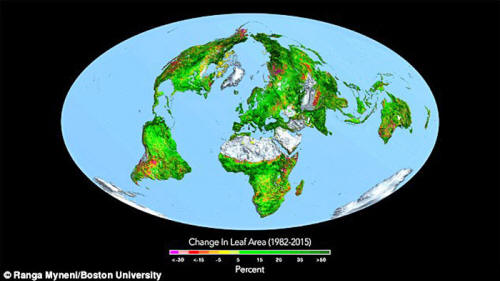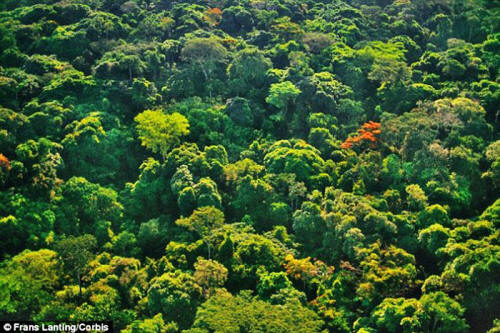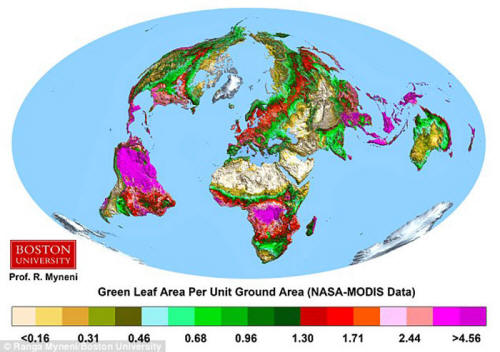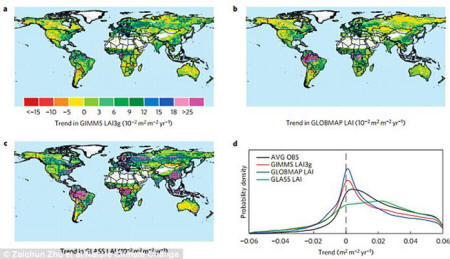|

by Richard Gray
25 April 2016
from
DailyMail Website
Scientists used satellite
data over the past 33 years to measure leaf cover.
Planet has got greener as plants have flourished in
rising carbon dioxide.
Additional plant growth is equivalent to covering the US
twice in greenery.
Rising carbon dioxide is responsible for 70 per cent of
the extra greening.
Extra Plant Growth
Caused by Greenhouse Gases
Could Cover the USA
Twice
The pumping of excessive carbon dioxide into the atmosphere has
widely been presented as setting our planet on a path towards
disaster.
But a new study has revealed rising levels of the greenhouse gas due
to humanity's actions is actually having a surprising side-effect -
it is making the Earth greener.
Satellite data gathered over 33 years has shown there has been a
'persistent and widespread increase' in the growing season of
plants.

The Earth is
getting greener
with rising carbon
dioxide levels,
researchers have
revealed.
They found over the
past 33 years,
leaf cover around
more than half of the vegetated area
of the world has
increased.
They say the extra
greenery is equivalent
to covering the USA
twice with plants
Scientists say up to half of the world's vegetated areas are now
showing signs of increased leaf cover, with the majority caused by
extra carbon dioxide in the atmosphere.
They added that the extra greening that has occurred in the past 33
years is equivalent to adding a green continent twice the size of
mainland USA - around 6.95 million square miles.
HOW PLANTS USE CARBON DIOXIDE TO HELP THEM
GROW
Plants use a process known as photosynthesis to trap carbon
dioxide from the air within their tissues. They do this using
the energy of the sun to combine carbon dioxide with water to
produce sugars that form their tissues.
With increased levels of carbon dioxide and sufficient sunlight,
plants can grow faster and bigger.
However, when carbon dioxide levels get too high it can become
toxic to plants.
Professor Ranga Myneni, an earth scientist at Boston
University who led the study, told MailOnline, however, this
effect is unlikely to continue for ever.
He said while the additional plant growth was helping to soak up
some of extra carbon being emitted into the atmosphere by human
activity, it may start slowing down.
He said:
'Currently, about a quarter of the
10 billion tons of carbon that we emit in to the air each year,
are being stored in the body of trees and in the soils.
'We do not know how long this will continue. This storage we do
know is temporary. Experiments have shown that the CO2
fertilization effect is temporary.
'The plants ultimately adjust to the higher levels of CO2
in the air.'
The researchers used data from the
Nasa-Modis and National Oceanic and Atmospheric Administration
AVHRR satellite sensors from the
past 33 years.
They used this to construct computer models to mimic the plant
growth observed in the satellite data.
Around 85 per cent of the ice-free land on the Earth's surface is
covered by vegetation. The area of all greenery on the Earth is
equal to around 32 per cent of the entire surface of the Earth.

The scientists
found much of the extra greening
due to rising carbon
dioxide levels is occurring
around the tropics
where large expanses
of tropical
rainforest (pictured) can be found

The
researchers used satellite data
to study how
leaf cover has changed
around the
world over the past 33 years.
They found many
areas have seen a
dramatic
increase in the amount of leaf cover
(illustrated
above)
Dr Zaichun Zhu, a researcher at
Peking University who also took part in the study, said:
'The greening over the past 33 years
reported in this study is equivalent to adding a green continent
about two-times the size of mainland USA and has the ability to
fundamentally change the cycling of water and carbon in the
climate system.'
Humans are thought to be emitting around
10 billion tons of carbon into the atmosphere every year.
Plants use carbon dioxide as part of the photosynthesis process to
produce sugars by combining the gas with water using energy from
sunlight. These sugars form much of the structures in plants and
ultimately provide a valuable food source to animals.
The researchers, whose work (Greening
of the Earth and Its Drivers) is published in the journal
Nature Climate Change, say their findings are consistent with
other studies that show how elevated carbon dioxide can
increase plant growth.
They found that,
-
carbon dioxide
fertilization, as the effect is known, is responsible for 70
per cent of the observed greening trend
-
nine per cent of the increased
greening was due to extra nitrogen in the soil
-
eight per cent was due to
climate change
-
four per cent of the greening
was due to land cover change
The impacts of increased carbon dioxide
was most prevalent over the tropics, where many of the large expanse
of rainforest can be found.
Climate change was responsible for
additional greening mainly in higher latitudes where ice is melting
and on the Tibetan Plateau.
However, they found the relationship between rising carbon dioxide
levels and the increase in greening is complex rather than a simple
correlation.

The
researchers said there had been an increase
in the growing season
in various parts of the world,
with up to 50 per
cent of the vegetated area of the Earth's surface
benefiting from
increased carbon dioxide (illustrated)
The results are likely to be seized upon
by climate change skeptics who claim increasing carbon dioxide
levels will not cause the levels of global warming predicted by many
scientists.
However, the researchers behind the new study (Greening
of the Earth and Its Drivers) said the impact of plants
in reducing global warming in recent years by moping up carbon
dioxide may now start to decrease.
Dr Philippe Ciais, another co-author of the study and
associate director of the Laboratory of Climate and Environmental
Sciences at Gif-suv-Yvette in France, said:
'The fallacy of the contrarian
argument is two-fold.
'First, the many negative aspects of climate change, namely
global warming, rising sea levels, melting glaciers and sea ice,
more severe tropical storms, etc. are not acknowledged.
'Second, studies have shown that plants acclimatize, or adjust,
to rising CO2 concentration and the
fertilization effect diminishes over time.'
|





